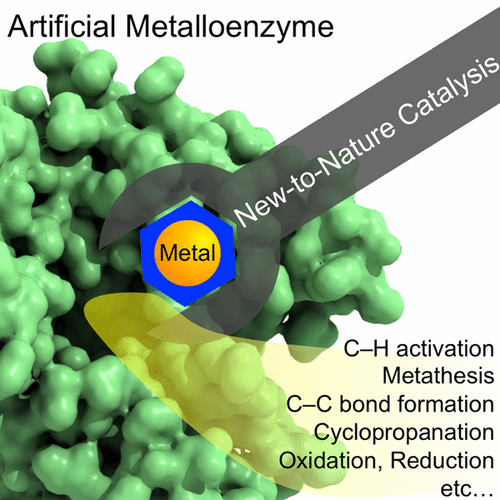当前位置:
X-MOL 学术
›
Chem. Rev.
›
论文详情
Our official English website, www.x-mol.net, welcomes your feedback! (Note: you will need to create a separate account there.)
Artificial Metalloenzymes: Reaction Scope and Optimization Strategies
Chemical Reviews ( IF 62.1 ) Pub Date : 2017-07-17 00:00:00 , DOI: 10.1021/acs.chemrev.7b00014 Fabian Schwizer 1 , Yasunori Okamoto 1 , Tillmann Heinisch 1 , Yifan Gu 2 , Michela M. Pellizzoni 1 , Vincent Lebrun 1 , Raphael Reuter 1 , Valentin Köhler 1 , Jared C. Lewis 2 , Thomas R. Ward 1
Chemical Reviews ( IF 62.1 ) Pub Date : 2017-07-17 00:00:00 , DOI: 10.1021/acs.chemrev.7b00014 Fabian Schwizer 1 , Yasunori Okamoto 1 , Tillmann Heinisch 1 , Yifan Gu 2 , Michela M. Pellizzoni 1 , Vincent Lebrun 1 , Raphael Reuter 1 , Valentin Köhler 1 , Jared C. Lewis 2 , Thomas R. Ward 1
Affiliation

|
The incorporation of a synthetic, catalytically competent metallocofactor into a protein scaffold to generate an artificial metalloenzyme (ArM) has been explored since the late 1970’s. Progress in the ensuing years was limited by the tools available for both organometallic synthesis and protein engineering. Advances in both of these areas, combined with increased appreciation of the potential benefits of combining attractive features of both homogeneous catalysis and enzymatic catalysis, led to a resurgence of interest in ArMs starting in the early 2000’s. Perhaps the most intriguing of potential ArM properties is their ability to endow homogeneous catalysts with a genetic memory. Indeed, incorporating a homogeneous catalyst into a genetically encoded scaffold offers the opportunity to improve ArM performance by directed evolution. This capability could, in turn, lead to improvements in ArM efficiency similar to those obtained for natural enzymes, providing systems suitable for practical applications and greater insight into the role of second coordination sphere interactions in organometallic catalysis. Since its renaissance in the early 2000’s, different aspects of artificial metalloenzymes have been extensively reviewed and highlighted. Our intent is to provide a comprehensive overview of all work in the field up to December 2016, organized according to reaction class. Because of the wide range of non-natural reactions catalyzed by ArMs, this was done using a functional-group transformation classification. The review begins with a summary of the proteins and the anchoring strategies used to date for the creation of ArMs, followed by a historical perspective. Then follows a summary of the reactions catalyzed by ArMs and a concluding critical outlook. This analysis allows for comparison of similar reactions catalyzed by ArMs constructed using different metallocofactor anchoring strategies, cofactors, protein scaffolds, and mutagenesis strategies. These data will be used to construct a searchable Web site on ArMs that will be updated regularly by the authors.
中文翻译:

人工金属酶:反应范围和优化策略
自1970年代末以来,一直在研究将合成的,具有催化作用的金属因子整合到蛋白质支架中以生成人工金属酶(ArM)。在随后的几年中,进展受到有机金属合成和蛋白质工程可用工具的限制。这两个领域的进步,加上对均相催化和酶催化的吸引人的特征相结合的潜在好处的日益加深认识,导致对ArM的兴趣从2000年代初开始兴起。潜在的ArM特性最吸引人的可能是它们赋予均相催化剂以遗传记忆的能力。实际上,将均相催化剂掺入遗传编码的支架中提供了通过定向进化改善ArM性能的机会。这种能力反过来可以导致ArM效率的提高,类似于从天然酶获得的效率,从而提供适用于实际应用的系统,并且可以更深入地了解第二配位球相互作用在有机金属催化中的作用。自2000年代初复兴以来,人造金属酶的各个方面都得到了广泛的审查和强调。我们的目的是根据反应类别,对截至2016年12月该领域的所有工作进行全面概述。由于ArM催化的非自然反应范围很广,因此可以使用官能团转化分类来完成。综述首先概述了迄今为止用于创建ArM的蛋白质和锚定策略,然后是历史观点。然后总结了由ArMs催化的反应和最终的关键前景。该分析允许比较使用不同金属化因子锚定策略,辅因子,蛋白质支架和诱变策略构建的ArM催化的相似反应。这些数据将用于在ArM上构建可搜索的网站,作者将定期对其进行更新。
更新日期:2017-07-17
中文翻译:

人工金属酶:反应范围和优化策略
自1970年代末以来,一直在研究将合成的,具有催化作用的金属因子整合到蛋白质支架中以生成人工金属酶(ArM)。在随后的几年中,进展受到有机金属合成和蛋白质工程可用工具的限制。这两个领域的进步,加上对均相催化和酶催化的吸引人的特征相结合的潜在好处的日益加深认识,导致对ArM的兴趣从2000年代初开始兴起。潜在的ArM特性最吸引人的可能是它们赋予均相催化剂以遗传记忆的能力。实际上,将均相催化剂掺入遗传编码的支架中提供了通过定向进化改善ArM性能的机会。这种能力反过来可以导致ArM效率的提高,类似于从天然酶获得的效率,从而提供适用于实际应用的系统,并且可以更深入地了解第二配位球相互作用在有机金属催化中的作用。自2000年代初复兴以来,人造金属酶的各个方面都得到了广泛的审查和强调。我们的目的是根据反应类别,对截至2016年12月该领域的所有工作进行全面概述。由于ArM催化的非自然反应范围很广,因此可以使用官能团转化分类来完成。综述首先概述了迄今为止用于创建ArM的蛋白质和锚定策略,然后是历史观点。然后总结了由ArMs催化的反应和最终的关键前景。该分析允许比较使用不同金属化因子锚定策略,辅因子,蛋白质支架和诱变策略构建的ArM催化的相似反应。这些数据将用于在ArM上构建可搜索的网站,作者将定期对其进行更新。


























 京公网安备 11010802027423号
京公网安备 11010802027423号